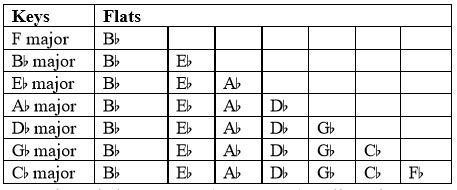Contemporary Music Theory
Pursuing Excellence
Personal Development
Leadership Principles
Administrative Skills
Major Scales With Flats

A similar pattern occurs with keys that have flats instead of sharps.
Below is a table of scales which have flats in the key signature. You may observe in the table the pattern in the key signatures which contain flats. The order in which flats are added is B♭ E♭ A♭ D♭ G♭ C♭ F♭ - exactly the reverse order of the sharps.
Memorise this sequence. Unlike the sharp key signatures, you take the second last flat added and that gives you the name of the key. For instance, given there are five flats in a key, you go through the sequence (BEADGCF) until you have named all five flats (BEADG), then you take the second last one (number four - D♭) and that is the name of the key - D♭.

If you are told that the name of the key is A♭ major, you run through your sequence until A♭ is the second last flat in it - BEAD. Therefore, the key of A♭ has four flats; B♭ E♭ A♭ D♭. (Most musicians would know that every major key also has a relative minor key with the same key signature, but we are concerned at present only with the major keys as they are the ones we will use to work out our chords.)
As with the order of sharps, you may already know that this is the order in which the flats appear in the key signature in written music.
To complete the picture on major scales, now read: Notes of the Major Scales
Understanding Scales | Understanding Chord Structure | Understanding Diatonic Chords | Understanding Minor Scales | Diatonic Chords in Minor Keys | Scale Degree Names | Chord Substitution - Extended Chords | Chord Substitution - Overlapping Chords | Improvisation - Arpeggios | Improvisation - Major Scales | Improvisation - Pentatonic Scales | Improvisation - Blues Scales